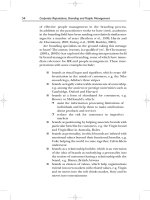Strategy and Sales Program Planning doc
Bạn đang xem bản rút gọn của tài liệu. Xem và tải ngay bản đầy đủ của tài liệu tại đây (310.73 KB, 38 trang )
Part I
THE BIG PICTURE
Chapter 2:
Strategy and Sales
Program Planning
The natural progression
How to make sales force and sales
program decision
Business
Strategy
Business
Strategy
Marketing
Strategy
Marketing
Strategy
Go-to-Market
Strategy
Supply Chain
Management (SCM)
Customer
Relationship
Management (CRM)
LEVEL 2
Strategy
Implementation
Decisions
Product Development
Management
(PDM)
LEVEL 1
Top
Management
Decisions
Figure 2-1 The Sales Force Decision Sequence
S
t
r
u
c
t
u
r
e
C
o
m
p
e
t
e
n
c
i
e
s
L
e
a
d
e
r
s
h
i
p
LEVEL 3
Sales Force
Program
Decisions
A
c
t
i
v
i
t
i
e
s
Account Relationship
Strategy
Business Strategy
Figure 2-2
: Factors Influencing Strategic Management
Distinct competencies
Marketing
Financial
Technology
Information
Distinct competencies
Marketing
Financial
Technology
Information
Environmental constraints
Legal & regulatory
Demographics
Economic Conditions
Technology
Competitive conditions
Sociocultural factors
Environmental constraints
Legal & regulatory
Demographics
Economic Conditions
Technology
Competitive conditions
Sociocultural factors
Strategic Management
Planning
Strategic Management
Planning
Resources
Financial
R&D
Personnel
Brand Equity
Production
Resources
Financial
R&D
Personnel
Brand Equity
Production
Firm’s history
management culture
Firm’s history
management culture
Marketing Strategy
Figure 2-3
: Hierarchy of Sales Objectives
Corporate goals
Maximize shareholder wealth
Corporate goals
Maximize shareholder wealth
Business unit objectives
12% revenue growth
Grow pre-tax profits by 18%
Business unit objectives
12% revenue growth
Grow pre-tax profits by 18%
Marketing objectives
Increase product A’s market share by 2 points
Grow contributions after sales & marketing by 20%
Marketing objectives
Increase product A’s market share by 2 points
Grow contributions after sales & marketing by 20%
Sales department objectives
Achieve sales revenue of $210 million
Grow contributions after sales expenses by 25%
Sales department objectives
Achieve sales revenue of $210 million
Grow contributions after sales expenses by 25%
Sales district objective
Achieve sales revenue of $10.5 million in product A
Obtain $7 million contributions after direct selling
Sales district objective
Achieve sales revenue of $10.5 million in product A
Obtain $7 million contributions after direct selling
Salesperson objective
Achieve sales revenues of $1.2 million in product A
Obtain $0.8 million in gross margin dollars
Salesperson objective
Achieve sales revenues of $1.2 million in product A
Obtain $0.8 million in gross margin dollars
Major account objective
Achieve sales revenues of $95,000 in product A
Obtain an average gross margin of 80%
Major account objective
Achieve sales revenues of $95,000 in product A
Obtain an average gross margin of 80%
A Look into What
Companies Want . . . .
0
10
70
60
50
40
30
20
29.8%
31.9%
66.1%
7.7%
14.0%
7.8%
Building
Brand of
Company/
product
Enhancing
credibility
of company
product
Increasing
sales/
revenue
Investor
relations
Saving
costs
Other
What Goals are Most Important to You?
0
100
60
80
40
20
Building
Brand of
Company/
product
Enhancing
credibility
of company
product
Increasing
sales/
revenue
Investor
relations
Saving
costs
Other
How Successful Were You at Reaching Your Goals?
68%
58%
72%
94%
83%
93%
32%
42%
28%
6%
17%
7%
Types of Strategies (Generic)
and Their Effect on Sales
Programs
Expand market
share in a high-
growth market
Harvest
Dives t
Secure
Added
Distribution
Add new
customers
Provide high
presale
services
Provide
product
& market
feedback
Focus on
volume
growth
Build current
relationships
Call on targeted
current
customers
Increase service
to current
customers
Call on
targeted new
customers
Focus on
account
penetration
Call on most
profitable
accounts only
Reduce overall
service levels
Reduce
inventory
levels
Maintain
distribution
Invest as
little time as
necessary
Marketing
Strategies
Sales
Strategies
Hold Strategy
Maintain market
share at the
lowest costs
possible
Harvest Strategy
Reduce costs
and focus on
profit, not market
share
Divest Strategy
Reduce
inventory
at lowest cost
possible
Eliminate
services
Offer
exceptional
pricing
Focus on
one time
sales
Minimize
time
commitment
Figure 2-4: Business Portfolio Analysis and Sales Force Strategy
Sales Force Ranking and Sales Growth:
Pharmaceuticals (1988-1990)
Low High
Sales Force Ranking
Growth
Sales Force Ranking and Sales Growth:
Computers (1988-1990)
Low High
Sales Force Ranking
Growth
A More Detailed Look at
Marketing Strategy
The Three Major Functions of
Marketing:
–
Segmentation
–
Targeting
–
Positioning
Strategic Implementation
Decisions
1. What is the best way to segment the market?
2. What are the essential activities required by
each segment?
3. What group of go-to-market participants should
perform the essential activities?
4. Which face-to-face selling participants should
be used?
Steps in Developing a Go-to-Market Strategy
Figure 2-6 Essential Activities
Interest Creation
Purchase
Pre-Purchase
Post-Purchase
Large
Small
Low Information,
Low Solution Needs
High Information,
High Solution Needs
Buying
Process
Customer Size
and
Opportunity
A Framework for Defining Essential Activities
Direct Sales
Force
Direct Sales
Force
Agents
Distributors
Retailers
Agents
Distributors
Retailers
Integrators
Integrators
Alliances
Alliances
Advertising
Promotion
Direct Mail
Advertising
Promotion
Direct Mail
Tele-
marketing
Tele-
marketing
Internet
Internet
Direct Indirect
Non-Sales Force OptionsSales Force Options
Company
Company
Customers and Prospects
Customers and Prospects
Figure 2-7 Potential Go-to-Market Participants
Figure 2-8 Comparing Various Go-to-Market Alternatives
Advertising
Direct Mail
Internet
Telemarketing
Sales Force
Effectiveness
Efficiency
High Sales
per Exposure
Low Cost
per Exposure
Customer Base
Customer Base
Account
Teams
Geographic
Sales Force
Direct Sales Force
Industry
Teams
Outbound
Inbound
Telemarketing
Partners Internet
Go-to-Market Strategy: A Large Computer Manufacturer
Customer Base
Customer Base
Account
Teams
Direct Sales Force
Inbound
Telemarketing
Go-to-Market Strategy: A Large Chemical Company
Customer Base
Customer Base
Account
Teams
Geographic
Sales Force
Direct Sales Force
Inbound
Telemarketing Partners
Go-to-Market Strategy: A Pharmaceutical Company









